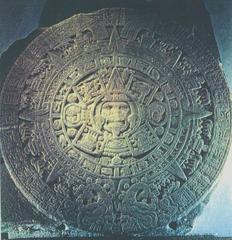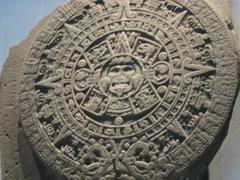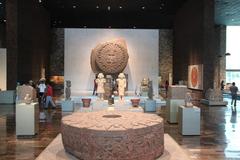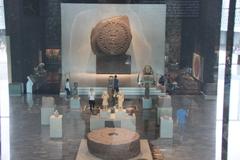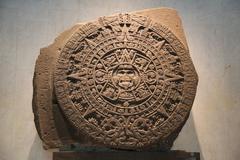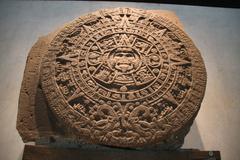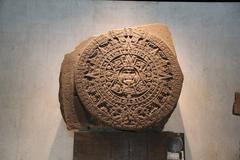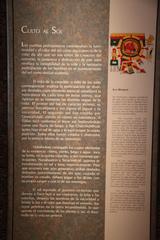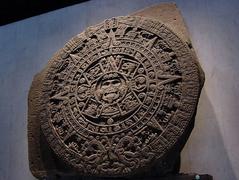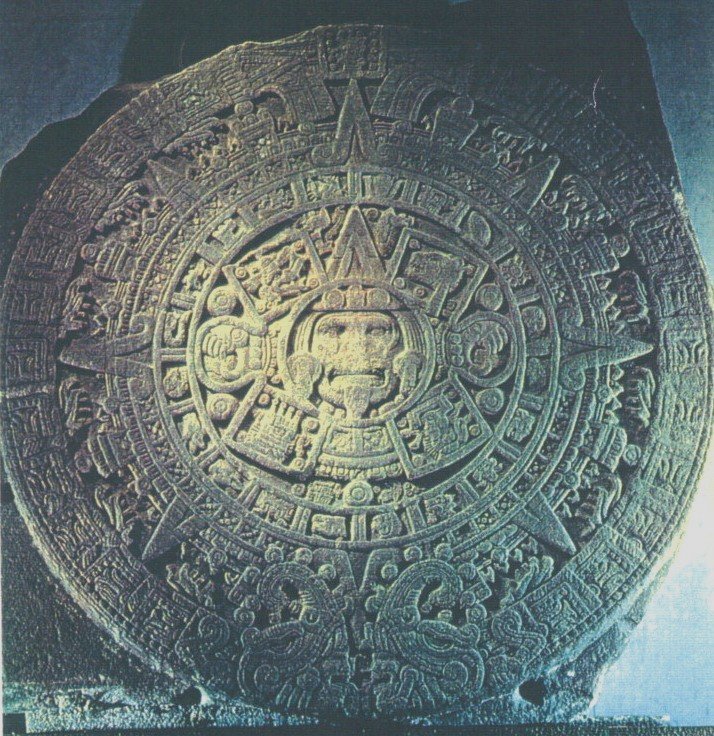
Aztec Sun Stone Visiting Hours, Tickets, and Guide to Mexico City Historical Sites
Date: 14/06/2025
Introduction
The Aztec Sun Stone, or Piedra del Sol, stands as one of the most important artifacts of pre-Columbian Mesoamerica and a defining emblem of Mexico’s indigenous heritage. Carved from a single basalt block, this monumental sculpture—measuring approximately 3.6 meters in diameter and weighing about 25 tons—not only encapsulates the cosmology and artistry of the Aztecs but also serves as a powerful symbol of cultural resilience. Housed at the National Museum of Anthropology (Museo Nacional de Antropología) in Mexico City, the Sun Stone draws thousands of visitors who seek to explore its intricate iconography and historical context. This comprehensive guide provides essential information on the Aztec Sun Stone’s history, symbolism, visiting logistics, accessibility, and nearby attractions to help you make the most of your Mexico City experience (Aztec Sun Stone: History, Visiting Hours, Tickets, and Travel Tips; Aztec Sun Stone: History, Symbolism, and Visitor Information; Aztec Sun Stone Visiting Hours, Tickets & Guide).
Historical Background
Creation and Rediscovery
Commissioned during the reign of Moctezuma II (1502–1520 CE), the Aztec Sun Stone was carved from basalt quarried in Tenanitla (now San Ángel) and transported over 12 miles to the ceremonial precinct of Tenochtitlan. The stone’s creation aligns with the height of the Aztec Empire, reflecting both its religious and political power.
After the Spanish conquest in 1521, the Sun Stone was buried—likely to suppress its ritual association. It remained hidden until December 1790, when it was unearthed during repairs at Mexico City’s cathedral. Since then, it has become a cornerstone of Mexican identity, symbolizing the endurance and complexity of Aztec civilization (TheTravel; SentinelMission.org).
Museum Relocation and Preservation
Initially displayed against the Cathedral’s wall, the Sun Stone was later moved to the National Museum of Archaeology and, in 1964, to its current home at the National Museum of Anthropology in Chapultepec Park. Here, it benefits from climate control and expert conservation, ensuring its preservation for future generations (Aztec Sun Stone: History, Visiting Hours, Tickets, and Travel Tips).
Symbolism and Cultural Significance
The Central Figure: Tonatiuh
At the center of the Sun Stone is the image of Tonatiuh, the Aztec sun god. He is depicted with a fearsome face, holding a stone blade as his tongue, symbolizing the necessity of sacrifice to sustain the sun and, by extension, the world. In his hands, he grasps human hearts, reinforcing the importance of ritual offerings in Aztec cosmology (Roaming Xplorer; Sand In My Suitcase).
The Five Suns: Aztec Cosmology
Surrounding Tonatiuh are four panels representing previous cosmic eras or “suns,” each destroyed by a different catastrophe: jaguars, wind, rain, and water. The current era, the Fifth Sun, is believed to be destined for destruction by earthquakes, a theme central to Aztec beliefs about cyclical time (Arts & Culture Google).
Tonalpohualli: The Sacred Calendar
Encircling the central image is a ring of 20 glyphs, each representing a day in the Aztec 260-day ritual calendar, the Tonalpohualli. This calendar was fundamental for divination and ceremonial scheduling, though the Sun Stone itself is a cosmogram—more symbolic than functional as a calendar (World by Isa).
Concentric Circles and Iconography
The stone’s design features concentric rings, including:
- First Ring: 20 day signs of the Tonalpohualli
- Second Ring: Boxes indicating sun rays and cardinal directions
- Outer Ring: Two fire serpents (Xiuhcoatl) with their tails meeting at the bottom and heads at the top, symbolizing time, fire, and renewal (Roaming Xplorer).
Ritual and Astronomical Function
Although often called a “calendar stone,” the Sun Stone served ceremonial and symbolic purposes. It was used as a platform for rituals, including human sacrifices to ensure the sun’s survival, and played a role in ceremonies marking the end of 52-year cycles—critical periods in Aztec belief (SentinelMission.org).
National Symbol and Modern Legacy
Today, the Sun Stone is an enduring national symbol, depicted in art, currency, and public celebrations. Its rediscovery and preservation highlight the ongoing dialogue between Mexico’s indigenous heritage and its modern identity (Aztec Sun Stone: History, Symbolism, and Visitor Information).
Visiting the Aztec Sun Stone: Essential Information
Location
- Where: National Museum of Anthropology (Museo Nacional de Antropología), Chapultepec Park, Mexico City
- Address: Av. Paseo de la Reforma & Calzada Gandhi s/n, Chapultepec Polanco, Miguel Hidalgo, 11560 Ciudad de México
Visiting Hours
- Open: Tuesday to Sunday, 9:00 AM – 7:00 PM
- Closed: Mondays and select public holidays
- Note: Always check the official website for the latest updates.
Tickets and Admission
- General Admission: Approximately 85–90 MXN (~$4–5 USD)
- Discounts: Free entry for children under 13, students, teachers, and seniors with valid ID on certain days
- Purchase: At the museum entrance or online via the official website
Accessibility
- The museum is fully wheelchair accessible, with ramps and elevators.
- Wheelchairs are available at the entrance.
- Restrooms, a café, and a gift shop are on site.
Guided Tours
- Guided tours available in Spanish and English.
- Tours can be booked through the museum or reputable tour operators.
- Audio guides and informational brochures are offered in multiple languages.
Photography
- Non-flash photography is permitted throughout the museum; tripods or professional equipment require permission.
Nearby Attractions
Enhance your visit by exploring these nearby sites:
- Chapultepec Park: One of the world’s largest urban parks, offering gardens, lakes, and recreation (The Broke Backpacker).
- Chapultepec Castle: Historic castle and the National Museum of History with panoramic city views.
- Templo Mayor: Archaeological site and museum in the historic center, showcasing Aztec ruins (Stories by Soumya).
- Zócalo: The city’s main square, surrounded by landmarks like the Metropolitan Cathedral.
- Museo de Arte Moderno and Museo Tamayo: Prominent art museums within Chapultepec Park.
- Polanco District: Upscale area with shopping, dining, and cultural venues (Voyage Mexique).
- Teotihuacan: Ancient city with iconic pyramids, a popular day trip from Mexico City (Lonely Planet).
Practical Travel Tips
- Arrive Early: Visiting in the morning or late afternoon helps avoid crowds.
- Transportation: The museum is accessible by metro (Auditorio or Chapultepec stations), bus, or taxi/Uber.
- Comfort: Wear comfortable shoes for walking; bring water, especially in summer.
- Tickets for Other Sites: Check separate admission requirements for attractions like Chapultepec Castle.
- Dining: Numerous restaurants and cafés are available in Polanco and Chapultepec Park.
Visual & Interactive Resources
- The museum offers virtual tours and interactive displays for an in-depth experience.
- High-quality images and online resources with descriptive alt text (e.g., “Aztec Sun Stone at National Museum of Anthropology”) are available on official platforms.
- Maps of Chapultepec Park highlight the museum’s location.
Frequently Asked Questions (FAQ)
Q: What are the Aztec Sun Stone visiting hours?
A: The museum is open Tuesday to Sunday, 9:00 AM to 7:00 PM. Closed Mondays.
Q: How much do tickets cost?
A: General admission is 85–90 MXN (~$4–5 USD). Discounts apply for students, children, and seniors.
Q: Is the museum accessible to people with disabilities?
A: Yes, with ramps, elevators, and available wheelchairs.
Q: Are guided tours available?
A: Yes, in Spanish and English. Booking in advance is recommended.
Q: Can I take photographs of the Sun Stone?
A: Yes, non-flash photography is allowed; check for the latest policies on professional equipment.
Q: How do I get to the museum?
A: By metro (Auditorio or Chapultepec stations), bus, or taxi/Uber.
Conclusion
The Aztec Sun Stone is a masterpiece of Mesoamerican art and cosmology, offering profound insights into the beliefs and artistry of the Aztec civilization. Its display at the National Museum of Anthropology makes it accessible to all, while the surrounding attractions of Chapultepec Park and central Mexico City allow visitors to immerse themselves in the country’s layered history.
For up-to-date information, ticketing, and special events, consult the National Museum of Anthropology’s official website or download the Audiala app for guided tours and travel tips. Explore, learn, and be inspired by the majesty of the Aztec Sun Stone on your next visit to Mexico City.
Sources and Further Reading
- Aztec Sun Stone: History, Visiting Hours, Tickets, and Travel Tips for Mexico City Historical Sites, 2025, World by Isa
- Aztec Sun Stone: History, Symbolism, and Visitor Information at Mexico City’s National Museum, 2025, Roaming Xplorer
- Aztec Sun Stone Visiting Hours, Tickets & Guide to Mexico City’s Iconic Historical Site, 2025, The Travel
- Sand In My Suitcase
- Arts & Culture Google
- SentinelMission.org
- aztec.mythologyworldwide.com
- The Broke Backpacker
- Stories by Soumya
- Voyage Mexique
- Lonely Planet
- Paul Passing Through
- As The Sparrow Flies
